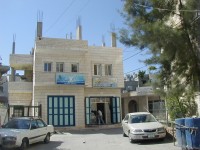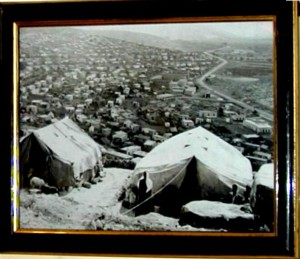Page 3 Visiting a Refugee Camp
Now, that raises the issue of the Palestinians who left in 1948.
It is hard to get a firm count on the number of refugees. The best
estimates I have seen suggest that three-quarters of a million became
refugees in 1948 and as many as half a million more in 1967. A 2005 estimate by
the UN said that at that time they had multiplied to nearly four
and a half million. In the Gaza strip about one and a half
million are in extremely crowded refugee camps. Gaza seemed too
dangerous to visit this summer, but we visited a refugee camp at just
south of Bethlehem, Dheisheh Camp.



It is tight, crowded, little open space or room to move. There
are 11000 people in less than one square kilometer, according to a web site about
it. The UN presence is very obvious, if sort of basic
-we couldn't help noticing UN garbage collectors taking trash to UN
dumpsters.



The children, like children everywhere, are adorable. There is a
very small storefront operated as a sort of community center, by IBDAA
- which in Arabic means, "to create something out of nothing," is
a
grassroots organization that provides educational, social, and cultural
programs for the children, youth and women of Dheisheh refugee
camp. They have managed to find a computer room and a place
outside the camp, for example, for children's athletic teams.


This little storefront has photos of what the camp used to be like - in
the early days there were tents, then tiny pillbox houses where there
was an extended family, sometimes 10 or 15 people, in a room.
There are photos of Palestine before 1948, pruning olive trees, family
groups.




The Palestinians have many posters - this one says "Fifty years under
the tent." They paint
the walls of the camp with pictures of "home."


The things we heard here were of considerable interest. One of
the refugees said, "Living in a refugee camp under Israeli control is
heaven compared to the camps in the Arab countries." In
Gaza
under Egyptian control, Lebanon, Syria, Jordan, often the residents are
not allowed out of the camps. While that was true for some years after
1967 here, and there were often curfews that lasted for weeks or months
when people were not allowed out of their tiny houses even to go to the
outhouse - there are horrible stories of people shot for curfew
violations - the gates were eventually opened, and there are now many
permanently open entrances to the camp. IF they can get a job or
money, residents who can afford it can go live elsewhere - but few can
afford it, and even some who do prefer to stay with the people from
their original village. There is a strong feeling that -if I stay in
the camp- I may eventually get my home back or payment; if I leave the
camp I may well no longer get what little UN or international sympathy
I have now.
Our guide in the camp - a worker for IBDAA - was a college student,
studying in Italy and home for the summer.

The schools in the camp are limited, overcrowded, and underfunded. Of
course right now all of Palestine has a real education problem.
After Hamas did well in the last Palestinian election, the US and
Israel did their best to cut off all funding to the Palestinian
government. The school teachers in Palestine hadn't been paid for
several months, when we were there.
I think one place that all our religions agree is that we need homes
for all these refugees, we need jobs, we need education.
>NEXT PAGE
Ordman Net Home
Israel/Palestine Info Home
CONTENTS:
Page 1: Introduction
Page 2: Kfar Shalem
Page 3: Duheisha Refugee Camp
Next> Page 4: Universities
Page 5: The Wall / Security Barrier
Page 6: Bethlehem
Page 7: Efrat
Page 8: Hebron
(More to come)














